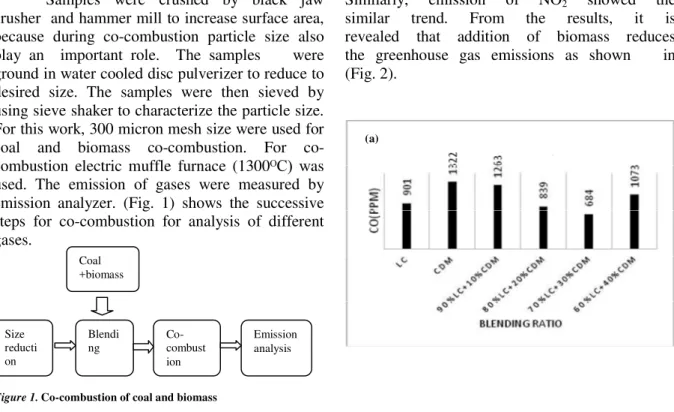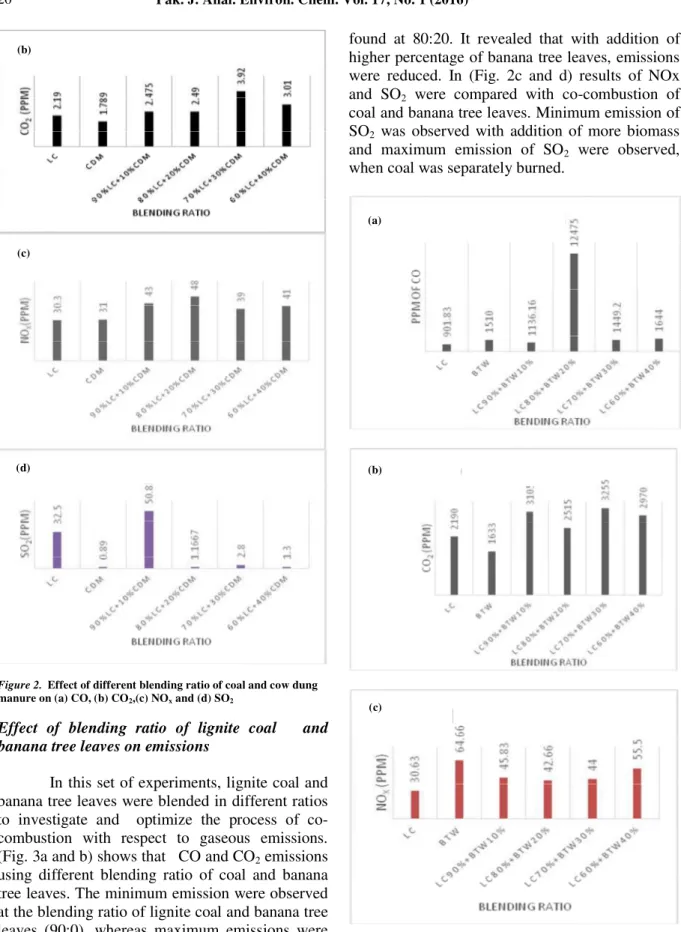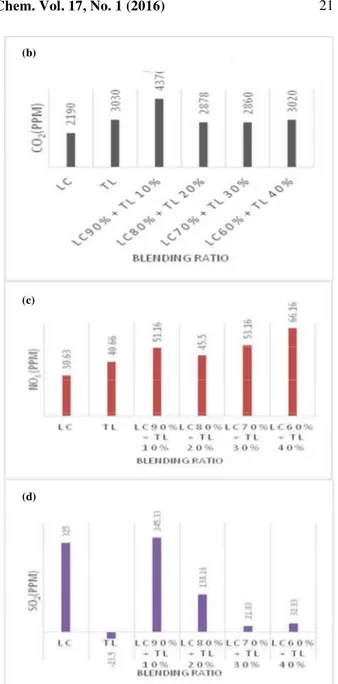Pak. J. Anal. Environ. Chem. Vol. 17, No. 1 (2016) 18 – 22
Comparative Study of Coal and Biomass Co-Combustion
with Coal Burning Separately Through Emissions Analysis
Mohammad Siddique
*1, Suhail Ahmed Soomro
2, Aziza Aftab
3, Zahid Naeem
Qaisrani
1, Abdul Sattar Jatoi
4, Asadullah
1, Ghulamullah Khan
1and Ehsanullah Kakar
5 1Chemical Engineering Department, BUITEMS, Quetta, Pakistan 2
Institute of Petroleum and Natural Gas Engineering, MUET Jamshoro Sindh, Pakistan 3
Department of Chemical Engineering MUET, Jamshoro, Pakistan 4
Chemical Engineering Department, MUET, Jamshoro, Pakistan 5
Faculty of Civil Engineering BUITEMS Quetta, Pakistan
*Corresponding Author Email: siddiqnasar786@gmail.com
Received 01 February 2016, Revised 23 June 2016, Accepted 27 June 2016
---Abstract
Appropriate eco-friendly methods to mitigate the problem of emissions from combustion of fossil fuel are highly demanded. The current study was focused on the effect of using coal & coal-biomass co-combustion on the gaseous emissions. Different coal-biomass' were used along with coal. The coal used was lignite coal and the biomass' were tree waste, cow dung and banana tree leaves. Various ratios of coal and biomass were used to investigate the combustion behavior of coal-biomass blends and their emissions. The study revealed that the ratio of 80:20 of coal (lignite)-cow dung and 100% banana tree leaves emits less emissions of CO, CO2, NOx and SO2 as
compared to 100% coal. Maximum amount of CO emissions were 1510.5 ppm for banana tree waste and minimum amount obtained for lakhra coal and cow dung manure (70:30) of 684.667 ppm. Maximum percentage of SO2 (345.33 ppm) was released from blend of lakhra coal and tree
leaves (90:10) and minimum amount of SO2 present in samples is in lakhra coal-banana tree
waste (80:20). The maximum amount of NO obtained for banana tree waste were 68 ppm whereas maximum amount of NOx was liberated from lakhra coal-tree leaves (60:40) and minimum amount from cow dung manure (30.83 ppm). The study concludes that utilization of biomass with coal could make remedial action against environment pollution.
Keywords: Lignite coal; Co-combustion; Biomass; Emission; Environmental friendly
---Introduction
Utilization of biomass in combustion processes is a promising way to reduce net greenhouse gas emissions, e.g. CO2, to atmosphere [1]. The use of biomass as an energy source has been utilized by techniques, such as, direct combustion, pyrolysis or fermentation for alcohol production. Until recently, there have been number of studies concerning the co-firing of coal/biomass blends for energy generation [2]. Some typical biomass fuels in co-firing studies are cattle manure, sawdust, sewage sludge, wood chips, straw and refuse-derived fuels. Biomass fuels are considered
environmentally friendly for several reasons. There is no net increase in CO2 because of burning biomass fuel. Therefore, blending of coal with biomass fuels can reduce fossil-based CO2 emissions. Co-firing brings additional greenhouse gas mitigation by reducing CH4 release as compared to landfilled biomass residues (sewage sludge, manure, etc.). The alkaline ash from biomass also captures some of the SO2 produced during combustion and therefore the net SO2 emissions can also be reduced. In addition, the nitrogen content in biomass in many cases is much
st th th
st th th lower than in coals and is mainly converted to
ammonia during combustion. Hence, co-firing can also result in lower NOxlevels. Blending can also result in the utilization of less-expensive fuels with a reduction in fuel costs. There are several works dealing with the effect of biomass addition on the gas emissions [3–15]. The current study is focused on the co-combustion of lignite coal and biomass in different ratios of both the components to optimize the process. The study was further extended to study the impacts of different ratios of lignite coal and biomass on the emissions.
Materials and Methods
Materials
For co-combustion coal and biomass was used. The coal used were lignite coal (LC) & the biomass used were tree leaves (TL), cow dung manure (CDM) and banana tree leaves (BTL). The coal-biomass were used in 90:10, 80:20, 70:30 and 60:40 ratio. Lignite coal was collected from Lakhra coal field. Three type of biomass were collected from different area of district Hyderabad, Pakistan.
Methods
Samples were crushed by black jaw crusher and hammer mill to increase surface area, because during co-combustion particle size also play an important role. The samples were ground in water cooled disc pulverizer to reduce to desired size. The samples were then sieved by using sieve shaker to characterize the particle size. For this work, 300 micron mesh size were used for coal and biomass co-combustion. For co-combustion electric muffle furnace (1300ᴼC) was used. The emission of gases were measured by emission analyzer. (Fig. 1) shows the successive steps for co-combustion for analysis of different gases.
Figure 1.Co-combustion of coal and biomass
To make different ratio of coal and biomass blends laboratory scale blender and electronic balance were used.
Results and Discussion
Effect of lignite coal and cow dung manure
blend on emissions
During co-combustion, the blending ratio of biomass and coal had a significant impact on emission of gases. In order to optimize blending ratio of coal and biomass, different blending ratios of lignite coal and cow dung manure were used to investigate the minimum ratio that generates less gaseous emissions. The ratio that have been used
were 90:10, 80:20, 70:30 and 60:40
st th th Figure 2. Effect of different blending ratio of coal and cow dung
manure on (a) CO, (b) CO2,(c) NOxand (d) SO2
Effect of blending ratio of lignite coal and banana tree leaves on emissions
In this set of experiments, lignite coal and banana tree leaves were blended in different ratios to investigate and optimize the process of co-combustion with respect to gaseous emissions. (Fig. 3a and b) shows that CO and CO2emissions using different blending ratio of coal and banana tree leaves. The minimum emission were observed at the blending ratio of lignite coal and banana tree leaves (90:0), whereas maximum emissions were
found at 80:20. It revealed that with addition of higher percentage of banana tree leaves, emissions were reduced. In (Fig. 2c and d) results of NOx and SO2 were compared with co-combustion of coal and banana tree leaves. Minimum emission of SO2 was observed with addition of more biomass and maximum emission of SO2 were observed, when coal was separately burned.
(b) CO2
NOX
(c)
SC2
(d)
(a)
(b)
(c)
CO2(PPM)
st th th Figure 3.Effect of different blending ratio of coal and banana tree
waste on (a) CO, (b) CO2, (c) NOxand (d) SO2
Effect of blending ratio of lignite coal and tree leaves on emissions
Another biomass that were used in the research was tree leaves with lignite coal in different ratios to investigate the potential use of biomass that contribute in reduction of environmental pollution and energy production. In (Fig. 2), different blends of lignite coal and tree leaves were used for identification of optimum results of co-combustion that generates less emissions. The maximum emission of CO and CO2 were observed at the blending ratio of lignite coal and tree leaves (70:30), whereas higher emissions were observed at 90:10.The emission of NOx, as a result of addition of biomass have not shown satisfactory results with reference to emissions t due to nitrogenous compound present in tree leaves. When we focus SO2emissions, addition of biomass gave a minimum amount of emission in terms of SO2.
Figure 4. Effect of different blending ratio of coal and tree leaves on (a) CO, (b) CO2,(c) NOxand (d) SO2
Conclusion
Comparative study was made by utilizing three different biomass with lignite coal for co-combustion. During co-combustion different blends of biomass and coal were employed for investigating the different ratios at which minimum gaseous emission emits. Minimum emissions of CO, CO2, NOx and SO2were observed at 80:20 ratio of lignite coal- cow dung manure and 100% banana tree waste. It was concluded that with
(d) SO2(PPM)
(c)
(d)
(a)
st th th saddition of biomass up to 30% could make less
emission of CO during co-combustion with coal. Furthermore, utilization of biomass with coal could make remedial action against environment pollution.
Acknowledgment
The authors acknowledges to the Chemical Engineering Department, Mehran University of Engineering & Technology, Jamsohor for providing the research facilities to carry out the research.
References
1. T. Saikaewa, P. Supudommaka, L.
Mekasuta, P. Piumsomboona, P.
Kuchontharaa, Int. J. Greenhouse Gas Control.,(2012) 26.
2. M. Sami, K. Annamalai, M. Wooldridge,
Prog. Energy Combust. Sci., 27 (2001) 171. 3. B. Leckner, M. Karlsson. Proceedings of the
12thInternational Conference on FBC., New York: ASME; (1993) 109.
4. A. Nordin,Fuel,74 (1995) 615.
5. I. Gulyurtu, E. Frade, H. Lopes, F. Figueiredo, I. Cabrita. Proceedings of the
14th International Conference New York:
ASME; (1997) 423.
6. L. Armesto, A. Cabanillas, A. Bahillo, J. J. Segovia, R. Escalada, J. M. Martinez, J. E. Carrasco, New York: ASME; (1997) 301.
7. E. Desroches-Ducarne, E. Marty, G. Martin, L. Delfosse.Fuel77 (1998) 1311.
8. K. R. G. Hein and J. M. Bemtgen. Fuel Process. Technol.,54 (1998) 159.
9. D. C. Dayton, D. Belle-Oudry and A. Nordin,Energ. Fuel13 (1999) 1203.
10. J. Werther, E. U. Hartge, K. Luecke, M. Fehr, L. E. Amand, B. Leckner New. VGB-Conference Research for Power Plant Technology; (2000) 1.
11. L. Amand, H. Miettinen-Westberg, M. Karlsson, B. Leckner, K. Luecke, S. Budinger, E. U. Hartge, J. Werther. Proceedings of the 16th International Conference on FBC, New York: ASME; (2001).
12. K. Laursen, J. R. Grace. Fuel Process Technol. 76 (2002) 77.
13. G. Skodras, P. Grammelis, P. Samaras, P.
Vourliotis, E. Kakaras and G. P.
Sakellaropoulos.Fuel81 (2002) 547.
14. A. B. Ross, J. M. Jones, S. Chaiklangmuang, M. Pourkashanina A. Williams, K. Kubica, J. T. Andersson, M. Kerst, P. Danihelka, K. D. Bartle.Fuel81 (2002) 571.
15. L. Armesto, A. Bahillo, A. Cabanillas, K. Veijonen, J. Otero, A. Plumed, L. Salvador.


